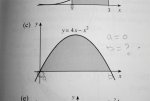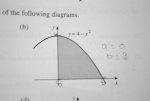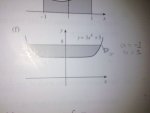You are using an out of date browser. It may not display this or other websites correctly.
You should upgrade or use an alternative browser.
You should upgrade or use an alternative browser.
Integrals + Area under the graph
- Thread starter 1141
- Start date
arthur ohlsten
Full Member
- Joined
- Feb 20, 2005
- Messages
- 852
y=4-x^2
let y=0
x^2=4
x=+/- 2
the value of b is 2,0
area= int. [4-x^2] dx from 0 to 2
===============================================================
y=4x-x^2 factor out x
y=x[4-x^2]
let y=0
0=x[4-x^2
x=0 or 4-x^2=0
4-x^2=0
x=+/-2
a=0
b=2
Arthur
let y=0
x^2=4
x=+/- 2
the value of b is 2,0
area= int. [4-x^2] dx from 0 to 2
===============================================================
y=4x-x^2 factor out x
y=x[4-x^2]
let y=0
0=x[4-x^2
x=0 or 4-x^2=0
4-x^2=0
x=+/-2
a=0
b=2
Arthur
Ah, so simple! I wasn't paying attention properly! Thanks.
I got the right answer for a.), but for b.) I only get half of what the correct answer should be. I get 16/3 when the answer should be 32/3.
Can you tell me where I went wrong.
?[sup:3bghdy9v]a[/sup:3bghdy9v][sub:3bghdy9v]b[/sub:3bghdy9v] f(x) dx
= ?[sup:3bghdy9v]2[/sup:3bghdy9v][sub:3bghdy9v]0[/sub:3bghdy9v] 4x - x[sup:3bghdy9v]2[/sup:3bghdy9v] dx
= [2x[sup:3bghdy9v]2[/sup:3bghdy9v] - 1/3x[sup:3bghdy9v]3[/sup:3bghdy9v]][sup:3bghdy9v]2[/sup:3bghdy9v][sub:3bghdy9v]0[/sub:3bghdy9v]
? I(a) = 2(0)[sup:3bghdy9v]2[/sup:3bghdy9v] - 1/3(0)[sup:3bghdy9v]3[/sup:3bghdy9v]
= 0
? I(b) = 2(2)[sup:3bghdy9v]2[/sup:3bghdy9v] - 1/3(2)[sup:3bghdy9v]3[/sup:3bghdy9v]
= 16/3
? I(b) - I(a)
= 16/3 -0
=16/3
I got the right answer for a.), but for b.) I only get half of what the correct answer should be. I get 16/3 when the answer should be 32/3.
Can you tell me where I went wrong.
?[sup:3bghdy9v]a[/sup:3bghdy9v][sub:3bghdy9v]b[/sub:3bghdy9v] f(x) dx
= ?[sup:3bghdy9v]2[/sup:3bghdy9v][sub:3bghdy9v]0[/sub:3bghdy9v] 4x - x[sup:3bghdy9v]2[/sup:3bghdy9v] dx
= [2x[sup:3bghdy9v]2[/sup:3bghdy9v] - 1/3x[sup:3bghdy9v]3[/sup:3bghdy9v]][sup:3bghdy9v]2[/sup:3bghdy9v][sub:3bghdy9v]0[/sub:3bghdy9v]
? I(a) = 2(0)[sup:3bghdy9v]2[/sup:3bghdy9v] - 1/3(0)[sup:3bghdy9v]3[/sup:3bghdy9v]
= 0
? I(b) = 2(2)[sup:3bghdy9v]2[/sup:3bghdy9v] - 1/3(2)[sup:3bghdy9v]3[/sup:3bghdy9v]
= 16/3
? I(b) - I(a)
= 16/3 -0
=16/3
D
Deleted member 4993
Guest
1141 said:Ah, so simple! I wasn't paying attention properly! Thanks.
I got the right answer for a.), but for b.) I only get half of what the correct answer should be. I get 16/3 when the answer should be 32/3.
Can you tell me where I went wrong.
?[sup:3jwrcj3n]a[/sup:3jwrcj3n][sub:3jwrcj3n]b[/sub:3jwrcj3n] f(x) dx
= ?[sup:3jwrcj3n]2[/sup:3jwrcj3n][sub:3jwrcj3n]0[/sub:3jwrcj3n] 4x - x[sup:3jwrcj3n]2[/sup:3jwrcj3n] dx
= [2x[sup:3jwrcj3n]2[/sup:3jwrcj3n] - 1/3x[sup:3jwrcj3n]3[/sup:3jwrcj3n]][sup:3jwrcj3n]2[/sup:3jwrcj3n][sub:3jwrcj3n]0[/sub:3jwrcj3n]
? I(a) = 2(0)[sup:3jwrcj3n]2[/sup:3jwrcj3n] - 1/3(0)[sup:3jwrcj3n]3[/sup:3jwrcj3n]
= 0
? I(b) = 2(2)[sup:3jwrcj3n]2[/sup:3jwrcj3n] - 1/3(2)[sup:3jwrcj3n]3[/sup:3jwrcj3n]
= 16/3
? I(b) - I(a)
= 16/3 -0
=16/3
Your limits are incorrect
Recalculate value of 'b'.
Okay, I got the right answer now. I recalculated "b" and it was equal to 4, not 2.
I have the same problem with two other questions - I get either half or doubled of what I'm supposed to get.
Attached are the two questions. The answer for e.) is supposed to be 500, but I get 250:
Here is my working:
?[sub:2a2ku9zi]a[/sub:2a2ku9zi][sup:2a2ku9zi]b[/sup:2a2ku9zi] f(x) dx
= ?[sub:2a2ku9zi]0[/sub:2a2ku9zi][sup:2a2ku9zi]5[/sup:2a2ku9zi] 6x[sup:2a2ku9zi]2[/sup:2a2ku9zi] dx
= [6( 1/3x[sup:2a2ku9zi]3[/sup:2a2ku9zi])][sub:2a2ku9zi]0[/sub:2a2ku9zi][sup:2a2ku9zi]5[/sup:2a2ku9zi]
=[2x[sup:2a2ku9zi]3[/sup:2a2ku9zi]][sub:2a2ku9zi]0[/sub:2a2ku9zi][sup:2a2ku9zi]5[/sup:2a2ku9zi]
? I(a) = 2(0)[sup:2a2ku9zi]3[/sup:2a2ku9zi]
= 0
? I(b) = 2(5)[sup:2a2ku9zi]3[/sup:2a2ku9zi]
= 250
? I(b) - I(a)
= 250 - 0
= 250
You have calculated the area "under" the curve - the question was about the area "over" the curve. so the answer should be
Area = 5 * 150 - 250 = 500
For question f.) the answer is supposed to be 16/3 but I get 32/3.
My working out:
?[sub:2a2ku9zi]a[/sub:2a2ku9zi][sup:2a2ku9zi]b[/sup:2a2ku9zi] f(x) dx
= ?[sub:2a2ku9zi]-1[/sub:2a2ku9zi][sup:2a2ku9zi]1[/sup:2a2ku9zi] 3x[sup:2a2ku9zi]8[/sup:2a2ku9zi] + 5 dx
= [3( 1/9x[sup:2a2ku9zi]9[/sup:2a2ku9zi]) + 5( 1/1x)][sub:2a2ku9zi]-1[/sub:2a2ku9zi][sup:2a2ku9zi]1[/sup:2a2ku9zi]
= [1/3x[sup:2a2ku9zi]9[/sup:2a2ku9zi] + 5x][sub:2a2ku9zi]-1[/sub:2a2ku9zi][sup:2a2ku9zi]1[/sup:2a2ku9zi]
? I(a) = 1/3(-1)[sup:2a2ku9zi]9[/sup:2a2ku9zi] + 5(-1)
= -16/3
? I(b) = 1/3(1)[sup:2a2ku9zi]9[/sup:2a2ku9zi] + 5(1)
= 16/3
? I(b) - I(a)
= 16/3 - (-16/3)
= 16/3 + 16/3
= 32/3
Can you tell me where I'm going wrong in these questions too?
I have the same problem with two other questions - I get either half or doubled of what I'm supposed to get.
Attached are the two questions. The answer for e.) is supposed to be 500, but I get 250:
Here is my working:
?[sub:2a2ku9zi]a[/sub:2a2ku9zi][sup:2a2ku9zi]b[/sup:2a2ku9zi] f(x) dx
= ?[sub:2a2ku9zi]0[/sub:2a2ku9zi][sup:2a2ku9zi]5[/sup:2a2ku9zi] 6x[sup:2a2ku9zi]2[/sup:2a2ku9zi] dx
= [6( 1/3x[sup:2a2ku9zi]3[/sup:2a2ku9zi])][sub:2a2ku9zi]0[/sub:2a2ku9zi][sup:2a2ku9zi]5[/sup:2a2ku9zi]
=[2x[sup:2a2ku9zi]3[/sup:2a2ku9zi]][sub:2a2ku9zi]0[/sub:2a2ku9zi][sup:2a2ku9zi]5[/sup:2a2ku9zi]
? I(a) = 2(0)[sup:2a2ku9zi]3[/sup:2a2ku9zi]
= 0
? I(b) = 2(5)[sup:2a2ku9zi]3[/sup:2a2ku9zi]
= 250
? I(b) - I(a)
= 250 - 0
= 250
You have calculated the area "under" the curve - the question was about the area "over" the curve. so the answer should be
Area = 5 * 150 - 250 = 500
For question f.) the answer is supposed to be 16/3 but I get 32/3.
My working out:
?[sub:2a2ku9zi]a[/sub:2a2ku9zi][sup:2a2ku9zi]b[/sup:2a2ku9zi] f(x) dx
= ?[sub:2a2ku9zi]-1[/sub:2a2ku9zi][sup:2a2ku9zi]1[/sup:2a2ku9zi] 3x[sup:2a2ku9zi]8[/sup:2a2ku9zi] + 5 dx
= [3( 1/9x[sup:2a2ku9zi]9[/sup:2a2ku9zi]) + 5( 1/1x)][sub:2a2ku9zi]-1[/sub:2a2ku9zi][sup:2a2ku9zi]1[/sup:2a2ku9zi]
= [1/3x[sup:2a2ku9zi]9[/sup:2a2ku9zi] + 5x][sub:2a2ku9zi]-1[/sub:2a2ku9zi][sup:2a2ku9zi]1[/sup:2a2ku9zi]
? I(a) = 1/3(-1)[sup:2a2ku9zi]9[/sup:2a2ku9zi] + 5(-1)
= -16/3
? I(b) = 1/3(1)[sup:2a2ku9zi]9[/sup:2a2ku9zi] + 5(1)
= 16/3
? I(b) - I(a)
= 16/3 - (-16/3)
= 16/3 + 16/3
= 32/3
Can you tell me where I'm going wrong in these questions too?
Attachments
When you take the integral of the curves in these situations, it is always equal to the area between a and b and between the curve and the x axis. That's always how it works in these situations. But they are not asking for that in your problems. But fortunately, you can use the area under the curves to figure out the answers anyway...
For e, the answer you are looking for is (the area of the square with sides 150 and 5) - (the area between the curve and the x axis).
Similar logic applies to f.
For e, the answer you are looking for is (the area of the square with sides 150 and 5) - (the area between the curve and the x axis).
Similar logic applies to f.
pitoten said:For e, the answer you are looking for is (the area of the square with sides 150 and 5) - (the area between the curve and the x axis).
Okay, I completely understand now! I don't know why I didn't see that before.
Thank you so much! I did each question again and I got right, first try.




